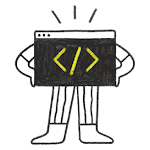In the last chapter, we defined a function as a collection of statements that execute sequentially. While that is certainly true, that definition doesn’t provide much insight into why functions are useful. Let’s update our definition: A function is a reusable sequence of statements designed to do a particular job.
You already know that every executable program must have a function named main (which is where the program starts execution when it is run). However, as programs start to get longer and longer, putting all the code inside the main function becomes increasingly hard to manage. Functions provide a way for us to split our programs into small, modular chunks that are easier to organize, test, and use. Most programs use many functions. The C++ standard library comes with plenty of already-written functions for you to use -- however, it’s just as common to write your own. Functions that you write yourself are called user-defined functions.
Consider a case that might occur in real life: you’re reading a book, when you remember you need to make a phone call. You put a bookmark in your book, make the phone call, and when you are done with the phone call, you return to the place you bookmarked and continue your book precisely where you left off.
C++ programs can work the same way. A program will be executing statements sequentially inside one function when it encounters a function call. A function call is an expression that tells the CPU to interrupt the current function and execute another function. The CPU “puts a bookmark” at the current point of execution, and then calls (executes) the function named in the function call. When the called function ends, the CPU returns back to the point it bookmarked, and resumes execution.
The function initiating the function call is called the caller, and the function being called is the callee or called function.
An example of a user-defined function
First, let’s start with the most basic syntax to define a user-defined function. For the next few lessons, all user-defined functions will take the following form:
The first line is informally called the function header, and it tells the compiler about the existence of a function, what the function is called, and some other information that we’ll cover in future lessons (like the return type and parameter types).
- In this lesson, we’ll use a return-type of int (for function main()) or void (otherwise). We’ll talk more about return types and return values in the next lesson (2.2 -- Function return values (value-returning functions)). For now, you can ignore these.
- Just like variables have names, so do user-defined functions. The identifier is the name of your user-defined function.
- The parentheses after the identifier tell the compiler that we’re defining a function.
The curly braces and statements in-between are called the function body. This is where the statements that determine what your function does will go.
Here is a sample program that shows how a new function is defined and called:
This program produces the following output:
Starting main() In doPrint() Ending main()
This program begins execution at the top of function main, and the first line to be executed prints Starting main().
The second line in main is a function call to the function doPrint. We call function doPrint by appending a pair of parentheses to the function name like such: doPrint(). Note that if you forget the parentheses, your program may not compile (and if it does, the function will not be called).
Warning
Don’t forget to include parentheses () after the function’s name when making a function call.
Because a function call was made, execution of statements in main is suspended, and execution jumps to the top of called function doPrint. The first (and only) line in doPrint prints In doPrint(). When doPrint terminates, execution returns back to the caller (here: function main) and resumes from the point where it left off. Consequently, the next statement executed in main prints Ending main().
Calling functions more than once
One useful thing about functions is that they can be called more than once. Here’s a program that demonstrates this:
This program produces the following output:
Starting main() In doPrint() In doPrint() Ending main()
Since doPrint gets called twice by main, doPrint executes twice, and In doPrint() gets printed twice (once for each call).
Functions calling functions calling functions
You’ve already seen that function main can call another function (such as function doPrint in the example above). Any function can call any other function. In the following program, function main calls function doA, which calls function doB:
This program produces the following output:
Starting main() Starting doA() In doB() Ending doA() Ending main()
Nested functions are not supported
Unlike some other programming languages, in C++, functions cannot be defined inside other functions. The following program is not legal:
The proper way to write the above program is:

